Session Report: “60 Years Since BCS and 30 Years Since Woodstock”
By Brian Schwartz, Brooklyn College and The Graduate Center of the City University of New York
Since the session dealt with physics history and was sponsored by the APS Forum on the History of Physics (FHP), it seems worthwhile to present some background as to how the session and its speakers came about. For the March 2017 meeting Alan Chodos, the FHP program chair (currently chair of the FHP Executive Committee) called me and indicated that the forum was interested in having a session celebrating the 60th anniversary of the 1957 BCS theory and needed an organizer. I accepted and proposed the title for the session, and some potential speakers.
In the past, for the 50th anniversary of BCS, the 2007 APS March meeting had two invited sessions: “50 Years of BCS Theory,” sponsored by the DCMP, and a second invited session, “20th Anniversary of High Tc Superconductivity ‘Woodstock’ Session.” Later that same year a comprehensive conference, “BSC@50” was held at the University of Illinois and a book based on the conference was published: “BCS: 50 Years,” edited by Leon N. Cooper and Dmitri Feldman, World Scientific (2010). In 2011, two APS March meeting sessions were held to celebrate the 100th anniversary of the discovery of superconductivity by Kammerlingh Onnes: a session called “The History of Superconductivity from its Discovery by Kammerlingh Onnes in 1911,” sponsored by the FHP, and another session, “The Kavli Foundation Special Symposium: Nobelist Perspectives on 100 Years of Superconductivity,” sponsored by the DCMP and DMS.
Alan Chodos suggested that I consider starting off with a talk by Andrew Zangwill (Georgia Tech), who had just finished a historical article on Walter Kohn and was in the middle of a book project on Phil Anderson. I agreed with Alan and invited Andy who, after checking with Phil, got Phil’s personal “top five” list of contributions to superconductivity. Andy suggested his talk title: “Phil Anderson and Superconductivity: An Appreciation of his Contributions.” Organizing the rest of the session was straightforward, choosing Paul Grant (W2AGZ Technologies and formerly IBM), to cover Woodstock, Richard Greene (University of Maryland), to review of experimental high temperature superconductivity, Doug Scalapino (University of California, Santa Barbara), on the status of the theory of both BCS and high Tc superconductors, and Neil Ashcroft (Cornell), to report on the latest high temperature experiments and theory involving hydrogen, especially the high Tc sulfides.
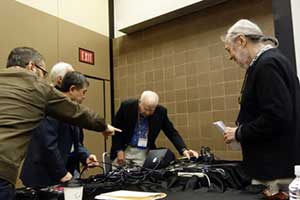
Superconductivity experts figuring out the projector
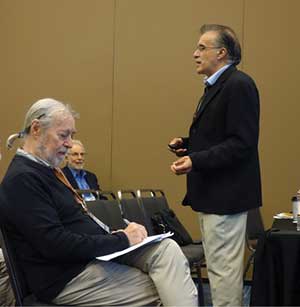
Piers Coleman of Rutgers University (standing) with session organizer Brian Schwartz (seated)
After I finalized the program and speakers for the session “60 Years since BCS and 30 Years since Woodstock,” two of the original speakers had to cancel suddenly, and fortunately two excellent substitutes generously agreed to speak. For the talk on Anderson, Piers Coleman (Rutgers) agreed to speak on Anderson’s contributions to superconductivity. Piers had recently coedited a book for Phil‘s 90th birthday in 2013, “PWA90: A Lifetime of Emergence,” World Scientific (2016). For the talk on hydrogen and superconductivity, Isaac Silvera (Harvard) agreed to speak on his recently published experiment results claiming to have produced and observed metallic hydrogen. The APS meetings staff was exceptionally cooperative in that they were able to include the new speakers and talks in the Bulletin even though the abstract deadline had long passed.
Almost all of the session speakers were old enough to be active in research in the 1950 and 60s, during the so-called “golden age of superconductivity’ and thus directly participated in its history. Alan Chodos and I noted that it seems unlikely that one will be able to have a BCS session with eyewitness researchers available to speak at the 75th anniversary.
Piers Coleman in his talk, “Phil Anderson’s Magnetic Ideas in Superconductivity,” discussed Anderson’s work on superconductivity, from his pseudo-spin formulation of the BCS theory, to the Anderson Higg’s mechanism and the resonating valence bond RVB theory of cuprate superconductivity. He divided Anderson’s contribution into different time periods. The 1950s included antiferromagnetism and the pseudospin formulation of superconductivity. The period from 1958 to 1963 was most productive and included: dirty superconductors, the theoretical and experimentally observed Josephson Effect, flux creep in type 2 superconductors and a prescient paper on “Plasmons, Gauge Invariance and Mass,” known as the Anderson Higgs Effect. In 1973 Anderson presented his theory of resonant valence bonds which showed that in copper oxide lattices, electrons from neighboring copper atoms interact to form a valence bond. With doping, however, the bonded electrons can be unlocked and form mobile superconducting Cooper pairs. This RVB concept was used by Anderson to explain the high Tc results first discovered by Bednorz and Muller in 1986.
Paul Grant’s talk, “The Woodstock of Physics: The Hyped Future Then (1987)…The Actual Situation Now (2017),” reviewed the experimental history of high temperature superconductors starting with the initial 1986 experiments of Alex Muller and Georg Bednorz on cooper oxide perovskites followed by the 93 K transition temperature detected in yttrium, barium, copper perovskites by Paul Chu. Their results were immediately confirmed leading to pandemonium at the March 1987 meeting at the New York Hilton termed ``The Woodstock of Physics.’’ Many speakers at the Woodstock meeting were forecasting that the discovery of high Tc superconductors (HTCS) would result in “the energy deliverance of mankind.” The immediate period after the discovery of high Tc was filled with optimistic proposed applications, but few practical uses followed. The bottom line then and now seems to be that despite the many successes of HTCS wire technology and the prototype testing of applications to transmission lines and other uses, there seems to be no significant commercial applications. Grant speculated that in the future power application might be one of the HTSC applications.
Richard Greene’s talk, “The Current Experimental Status of the High Tc Problem,” started by noting that over 50,000 experimental papers had been published since 1987 on the copper oxide (cuprate) high Tc superconductors. He summarized the experimental properties that are understood presently and those not yet understood. He then listed the many improved experimental measuring techniques such as ARPES, SI-STM(QPI), RIXS, Quantum Design MPMS and PPMS and the availability of higher magnetic fields. In addition, there are improved and available high Tc materials. He presented the layered crystal structure of cuprate superconductors and illustrated the frustration of antiferromagnetism with doping. Ultimately, he presented a phase diagram of the cuprates constructed from many separate experiments (figure 1). Greene ended his talk with the big question remaining, “What causes the Cooper pairing in HTSC?”
Doug Scalapino in the title his talk asks the question, “Why did it take over 40 years from the experimental discovery of superconductivity to the BCS theory and will it take this long to understand the high Tc superconductors?” He summarized the experimental advances and theoretical clues from the discovery of superconductivity in 1911 until 46 years later with the BCS theory in 1957. He also described the many failed attempts to explain superconductivity by such noted physicists as Albert Einstein, Felix Bloch, Lev Landau, Walter Heisenberg and others. Hints to the solution were implied in the phenomenological theory of Heinz and Fritz London, indicating a likely phase transition with long-range order. In 1950, through the isotope effect, electron-phonon interactions were implicated in the mechanism for superconductivity, leading to the attractive force for pairing of electrons calculated by Cooper and then followed by the BCS theory. However, even after more than thirty years of intensive theoretical and experimental research, the origin of HTCS is still not clear. It seems that for HTCS, one is dealing with more exotic electronic mechanisms (e.g. by antiferromagnetic correlations), and instead of conventional, purely s-wave pairing, more pairing symmetries are thought to be involved (d-wave in the case of the cuprates; primarily extended s-wave, but occasionally d-wave, in the case of the iron-based superconductors). Scalapino listed the many theoretical ideas for high Tc and discussed Anderson’s RVB approach, spin fluctuation pairing, nematic pairing, loop currents and more. Scalapino stated his belief that for the HTCS materials, we are close to understanding the high Tc problem and that the Hubbard model plays an important role in the understanding of HTCS. He concluded that: 1) the pairing is mediated by short range AF spin fluctuations, 2) the pairing emerges from a delicately balanced phase dependent upon near neighbor hopping and 3) the theory includes the many different HTCS materials.



Paul Grant of EPRI (top), Richard Greene from the University of Maryland (middle), and Douglas Scalapino of the University of California, Santa Barbara (bottom)
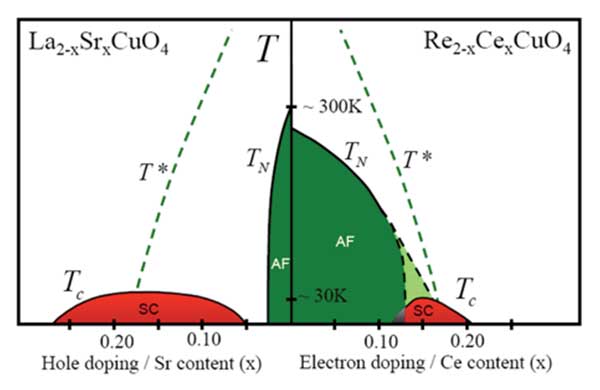
Figure 1: Phase diagram of the cuprates The T*green dotted line on the right is AFM fluctuations and the T* on the left is unknown N.P. Armitage, P. Fournier and R.L. Greene, Rev. Mod. Phys. 82, 2421 (2010)
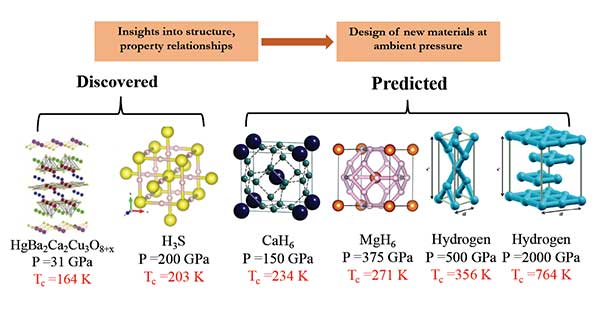
Figure 2: Hydrogen and Poly-Hydrides under Pressure N.W. Ashcroft, Phys. Rev. Lett. 92, 187002 (2004)
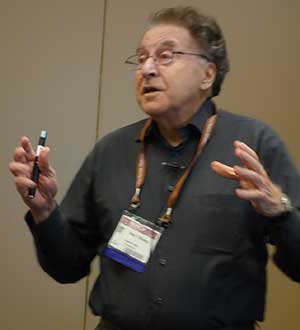
Isaac Silvera of Harvard University
The final paper in the session was by Isaac Silvera on “Pressing Hydrogen into an Atomic Metallic Phase: Implications for Superconductivity.” In 1935 physicists Wigner and Huntington predicted that hydrogen would become a metal at very high pressure. That prospect was made even more enticing when, in 1968, physicist Neil Ashcroft showed that metallic hydrogen might become superconducting at room temperature (figure 2). Silvera described his experiment in which a hydrogen sample at a temperature of around 5.5K was squeezed between the teeth of a diamond anvil cell that created multi-megabar static pressures. Based on his calibration of the pressure scale, Silvera claimed that metallization took place at 495 gigapascals (GPa). At this pressure point, the sample – which they could not identify definitively as solid or liquid – change from black and opaque to the highly reflective characteristic of a metal. His result, claiming to have observed metallic hydrogen, remains controversial and thus he had to counter the criticism of the experiment in that the pressure was overestimated. A further complication was the fact that his sample, in which he claimed to observe metallic hydrogen, broke after the measurements were made. Silvera concluded his talk by listing his plans for the future: to repeat the experiment, to use X-ray to determination of ground state structure, (liquid or solid), to measure the conductivity vs T to test for superconductivity, and to show if the state is metastable, and to produce metallic hydrogen at lower pressures.
The articles in this issue represent the views of their authors and are not necessarily those of the Forum or APS.
